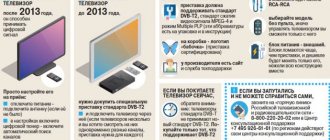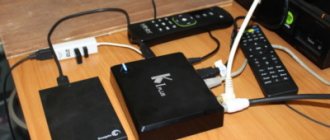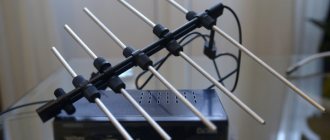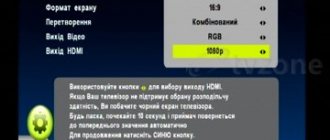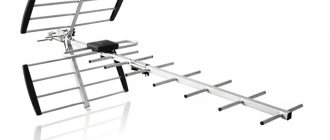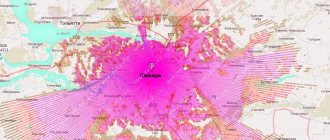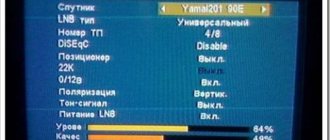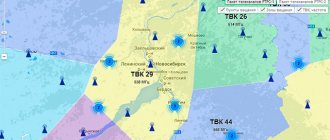How to connect digital?
Important. To connect digital channels, the TV must support the DVB-T2 standard.
Almost all models released in the last few years are capable of this. For older TVs, you will have to buy additional equipment. It is not expensive - around 800 rubles. You can determine support for the required standard by reading the operating instructions for your TV device.
Necessary equipment
If the TV itself does not support the digital standard, then you will need to purchase a set-top box. Before purchasing this device, you need to carefully study the inputs and outputs that the TV is equipped with.
They are located on the side and front of the TV. Usually, cables with bells (tulips) are included with the digital set-top box. If the TV is equipped with such inputs and outputs, then these wires will be quite sufficient to connect the set-top box.
Attention. If the TV model has only a SCART output, you need to additionally purchase equipment with a SCART to “bell” transition.
An HDMI cable can also be used as a connection method if the TV has such inputs. Almost all modern set-top boxes have such a connector, but the cable itself must be purchased additionally.
The most important thing is to have a decimeter television antenna. In an apartment building, a collective antenna is suitable for this. If you use an indoor one, it should be close to the TV tower and in direct line of sight.
At a great distance from the television tower, you will need an “active antenna,” that is, a device with an amplifier. To view digital and analogue channels simultaneously, it is recommended to use an all-wave antenna.
How to setup?
If your TV supports digital broadcasting, then setting it up is simple:
- Digital television in the Tver region settings
- connect the antenna to the TV;
- run “Auto-tuning channels”;
- save all found channels and you can enjoy watching.
If the TV only receives digital signals using a set-top box, then first you need to connect it. Also connect an antenna to it. Switch the TV to set-top box mode and automatically tune in channels.
Doesn't show CETV. What to do?
25.First of all, ask your neighbors how they are doing with their digital terrestrial television reception.
If everything is fine with your neighbors, but you have some difficulties, then the problem is in your receiving user equipment (antenna, set-top box or TV). 26. If the TV finds only 10 digital channels out of 20 (usually the first multiplex) or the image is “unstable” (constantly “scattered”), most likely the problems are related to the wrong choice or installation of the antenna (the antenna does not meet the reception conditions). This means that during reception, a sufficient signal level is not provided and it is necessary to use a more powerful antenna (with an amplifier or higher gain), raise it higher and accurately orient it towards the transmitting station.
27. If “yesterday everything showed, but today there is nothing”: check the receiving equipment, cables and all connections. The antenna cable may be damaged (especially for street antennas) or the antenna may be faulty (the amplifier burned out due to a power surge, etc.).
28. Be sure to check the outdoor antenna after a thunderstorm, snowfall, or strong gusts of wind. It could simply be blown around by the wind and signal reception would become difficult.
29. Also, periodic problems with the picture (freezing, scattering) can be caused by incorrect operation of the set-top box. Like any high-tech device, it can accumulate errors. This can be eliminated by completely “rebooting” it: turning it off from the remote control, turning it off from the mains and turning it on again.
30. If out of 20 channels the Russia-1 and Russia-24 channels are not shown, you need to update the software (“firmware”) of the set-top box or TV (if the TV is a modern model and works without a set-top box). New software can be downloaded from the equipment manufacturer's website. The update on the set-top box or TV is carried out from a USB flash drive.
What are the broadcast frequencies for manual tuning?
When tuning manually, you need to know the broadcast frequency. In the Nizhny Novgorod region and Nizhny Novgorod, the broadcast is carried out in two bands. Each of the presented frequencies has 10 separate channels. A total of 20 free federal channels are presented:
- Multiplex 1 - 28 TVC (530 MHz).
- Multiplex 2 - 53 TVC (730 MHz).
Reference. Multiplex is a combination of TV channels that send different television centers to one repeater, which already distributes packet distribution to individual receivers.
The advantages are obvious:
- The user does not need to switch TVCs, since all programs can be found on one channel in the settings.
- There is no need to obtain a license to broadcast on a specific frequency.
- Repeaters that operate on one frequency are simpler in design than multi-frequency tax towers.
At the moment there are two working and one testing multiplex. It has not yet been officially launched, while 1 multiplex has been operating for more than 5 years, and the second not so long ago, but is already fully operational.
To clarify information on a specific locality, you can go to the website SMOTRICIFRU.RF.
In case of reset of digital TV settings from November 22, Nizhny Novgorod residents need to retune channels
In case of resetting or changing the settings of digital television equipment from November 22, 2021, Nizhny Novgorod residents need to retune the channels.
On November 29, in all regions of Russia, information blocks of mandatory public regional television channels will appear as part of digital terrestrial television broadcasting programs. In the Nizhny Novgorod region, the TV channel of the 21st button is tele. The blocks will be included in the network of the Public Television of Russia TV channel (OTR, button 9 in the first multiplex of digital terrestrial television). They will be allocated 5 hours a day.
In November, regional branches of RTRS will carry out technical work to change the settings of the transmitting equipment of the first multiplex. At the moment when the work is completed and the signal from the first multiplex begins to be broadcast with changed parameters, this may cause the population to reset the settings on some models of television receivers. In the Nizhny Novgorod region, the start of broadcasting a television signal with changed parameters will take place from November 21 to 22. Viewers will need to retune TV channels - automatically or manually.
HELP for setting up CETV channels
- Carefully read the operating instructions for your TV or set-top box.
- Setting up CETV channels in automatic mode.
In the TV (set-top box) menu, using the television remote control (set-top box), select SETUP - AUTO SEARCH. After this, wait for the system to auto-search for channels.
- Tuning CETV channels manually.
In the TV or set-top box menu, you need to select CHANNEL SETUP - MANUAL SEARCH. Next, select the decimeter range (UHF), set the frequency channel SN, the bandwidth (or bandwidth) - 8 MHz and indicate the TVC or broadcast frequency of the first and second multiplexes in your locality.
You can clarify TVCs and broadcast frequencies of CETV packages in a specific locality on the SMOTRICIFRU.RF website in the section HOME / FOR TV VIEWERS / CONSTRUCTION OF A DIGITAL TV NETWORK (https://nnovgorod.rtrs.ru/tv/digital/). On the same site you can find information on selecting, connecting and setting up DTTV in the section HOME / FOR TV VIEWERS / EVERYTHING FOR RECEPTION (https://nnovgorod.rtrs.ru/tv/connect/)
- Detailed recommendations for setting up DTTV channels depending on the models of receiving user equipment (TV or set-top boxes) are described in the operating instructions for the equipment or on the manufacturer’s website.
- Updating the software of your TV or set-top box.
Software update is recommended in cases where the installed software is outdated and the device does not work correctly. The software can be found on the website of the TV or set-top box manufacturer. If there is new software for your TV model or set-top box on the manufacturer's website, install it strictly following the included instructions.
How many free channels - list
All residents of Novgorod and the Nizhny Novgorod region are provided with 20 free channels. These include all federal broadcasting channels.
- Terrestrial digital television in Kirov for 1,500 rubles
1 Multiplex:
- First;
- Russia 1;
- Match TV;
- NTV;
- Petersburg;
- Russia-culture;
- Russia 24;
- Carousel;
- OTR;
- TV center.
2 Multiplex:
- REN TV;
- SAVED;
- STS;
- Home;
- TV 3;
- Friday;
- Star;
- WORLD;
- TNT;
- Muz TV.
Regional and some other channels remain on analogue television, so if the user needs them, he must purchase an all-wave antenna and continue to watch them.
Attention. You can get advice on connecting digital television by calling the hotline, which operates throughout Russia. There is also a regional number for residents of Nizhny Novgorod: 8 (831) 422-14-21.
Digital television broadcasting has covered the entire country. The Nizhny Novgorod region is also connecting to modern television broadcasting. From June 3, 2021, analogue TV will be switched off, with the exception of channels that are not broadcast in digital format. Therefore, citizens need to connect and configure CETV.
If the TV model is modern, then it has a built-in tuner for digital broadcasting. Otherwise, you will have to purchase an additional attachment. This can be done in household appliances and electronics stores, as well as in Russian post offices. The cost of the set-top box is 800-1000 rubles. There is no point in purchasing more expensive models; they have additional options that do not affect the transmission of the digital signal.
Residents of Nizhny Novgorod and the Nizhny Novgorod region can receive advice on the transition to digital terrestrial television broadcasting by calling the regional hotline 8 (831) 422-14-21 . You can call the same phone number for help from volunteers in connecting to digital television.
In addition, you can find out more about the transition to DTTV and turning off analogue broadcasting by calling the federal hotline 8 800-220-20-02.
Reference. The transition to digital terrestrial television is carried out in accordance with the federal target program “Development of television and radio broadcasting in the Russian Federation for 2009-2018” (FTP). The Federal State Unitary Enterprise "Russian Television and Radio Broadcasting Network" is the only executor of the Federal Target Program for the construction of a digital terrestrial television network. As part of the Federal Target Program, the Nizhny Novgorod branch of RTRS created an infrastructure in the region for broadcasting two multiplexes of digital terrestrial television, consisting of 43 radio television stations (RTS).
- Digital channel frequency: how to determine it
First multiplex: Channel One, Russia 1 (with regional broadcasting of State Television and Radio Broadcasting Company "Nizhny Novgorod"), Match-TV, NTV, St. Petersburg - Channel 5, Russia-Culture, Russia 24 (with regional broadcasting of State Television and Radio Broadcasting Company "Nizhny Novgorod"), Karusel, OTR , TV (with regional broadcasting of State Television and Radio Broadcasting Company "Nizhny Novgorod"), Radio "Mayak" and "Vesti FM". The composition of the first multiplex was determined by the Decree of the President of the Russian Federation.
Second multiplex: REN-TV, SPAS, STS, Home, TV-3, Friday, Zvezda, Mir, TNT, Muz-TV. The composition of the second multiplex was formed by decisions of the Federal Competition Commission for Television and Radio Broadcasting. Digital terrestrial television channels are free access channels and are broadcast without a subscription fee.
To receive digital terrestrial television, you need an antenna operating in the UHF range, as well as a TV that supports the DVB-T2 standard. Almost all modern TVs released in the last 3-4 years support this standard by default. A digital set-top box with DVB-T2 support must be connected to a previous generation TV.
Digital multiplexes in Nizhny Novgorod The launch date for the third multiplex has not been determined. The antenna has been installed on the Nizhny Novgorod TV tower.
Current prices can be checked by contact numbers or by downloading the price list .
Digital television (from the English Digital Television, DTV) is a technology for transmitting television images and sound by encoding video and audio signals using digital channels. The basis of modern digital television is the MPEG data compression standard. By decision of the Government of the Russian Federation, MPEG-4 was adopted as the basic DTV format. On September 22, 2011, at a meeting of the Government Commission for the Development of Television and Radio Broadcasting chaired by First Deputy Chairman of the Government of the Russian Federation I.I. Shuvalov approved the use of the new DVB-T2 standard. In all newly created terrestrial networks, digital television broadcasting will be carried out in the DVB-T2 standard. The Nizhny Novgorod region is just such a region. Our network will be built in the DVB-T2 standard. DVB-T2 (Digital Video Broadcasting – Second Generation Terrestrial) is the second generation of the European DVB digital broadcasting standard. The DVB-T2 standard allows you to increase the information capacity of digital television broadcasting networks by at least 30% compared to DVB-T with the same network topology and frequency resources. And this is an opportunity to increase the number of channels transmitted in one multiplex, the possibility of transmitting additional information, the possibility of developing high-definition television. Please note: DVB-T receiving user equipment does not support the DVB-T2 standard. Owners of TVs with DVB-T tuners will need additional receiving devices (DVB-T2 set-top boxes).
The transition to digital is carried out within the framework of the Federal Target Program. In Nizhny Novgorod, digital terrestrial television programs are broadcast on 28 TVCs (broadcast frequency 530 MHz).
Digital terrestrial television multiplexes The first multiplex includes ten television channels:
| "First channel" | "Russia 1" | "Match TV" |
| "NTV" | "Petersburg-5 channel" | "Russia K" |
| "Russia 24" | "Carousel" | "Public Television of Russia" |
| "TV Center - Moscow" |
The first multiplex also has three radio channels:
• Radio Russia • Mayak • Vesti FM Channels of the second multiplex by 2015 will be available throughout Russia without a subscription fee:
| "REN TV" | "SAVED" | "The first entertainment STS" |
| "Home" | "TV-3" | Friday |
| "STAR" | "WORLD" | "TNT" |
| "Muz TV" |
Television terrestrial analogue channels of Nizhny Novgorod
| item no. | TV channel | TV company | Power, kWt) | Broadcast frequency |
| 1 | 2 | First channel | 5 | (MV-1) - 59.25 MHz - 65.75 MHz |
| 2 | 3 | STS-Nizhny Novgorod | 1 | (MV-1) - 77.25 MHz - 83.75 MHz |
| 3 | 4 | Russia 24 / NNTV | 3 | (MV-1) - 85.25 MHz - 91.75 MHz |
| 4 | 6 | TNT-Nizhny Novgorod | 1 | (MV-2) - 175.25 MHz - 181.75 MHz |
| 5 | 7 | Volga | 2 | (MV-2) - 183.25 MHz - 189.75 MHz |
| 6 | 9 | NTV | 1 | (MV-2) - 199.25 MHz - 205.75 MHz |
| 7 | 10 | Russia 1 / State Television and Radio Broadcasting Company Nizhny Novgorod | 5 | (MV-2) - 207.25 MHz - 213.75 MHz |
| 8 | 11 | Home / NTVK | 2 | (MV-2) - 215.25 MHz - 221.75 MHz |
| 9 | 12 | REN TV / NN Networks | 5 | (MV-2) - 223.25 MHz - 229.75 MHz |
| 10 | 23 | Russia K | 1 | (UHF) - 487.25 MHz - 493.75 MHz |
| 11 | 26 | Channel 5 | 1 | (UHF) - 511.25 MHz - 517.75 MHz |
| 12 | 29 | YU | 0.9 | (UHF) - 535.25 MHz - 541.75 MHz |
| 13 | 31 | TV3 / Nika TV | 5 | (UHF) - 551.25 MHz - 557.75 MHz |
| 14 | 36 | Disney TV | 1 | (UHF) - 591.25 MHz - 597.75 MHz |
| 15 | 39 | Russia 2 | 1 | (UHF) - 615.25 MHz - 621.75 MHz |
| 16 | 41 | Yu / Bor-TV (Bor) | 1 | (UHF) - 631.25 MHz - 637.75 MHz |
| 17 | 44 | Pepper/Dialogue | 5 | (UHF) - 655.25 MHz - 661.75 MHz |
| 18 | 49 | TV Center/Strezhen | 5 | (UHF) - 695.25 MHz - 701.75 MHz |
| 19 | 51 | MTV | 5 | (UHF) - 711.25 MHz - 717.75 MHz |
Note: (MV-1) - the first meter range, (MV-2) - the second meter range, (UHF) - the decimeter range. (kW) - transmitter power in kilowatts.
Television broadcasts of cities and villages of the Nizhny Novgorod region
Television channels of Arzamas
| item no. | TV channel | TV company | Power, kWt) | Broadcast frequency |
| 1 | 6 | First channel | 5 | (MV-2) - 175.25 MHz - 181.75 MHz |
| 2 | 9 | NNTV/RIK/TVS-9Y channel/TRK Arzamas | 0.2 | (MV-2) - 199.25 MHz - 205.75 MHz |
| 3 | 11 | Russia 1 | 5 | (MV-2) - 215.25 MHz - 221.75 MHz |
| 4 | 21 | Russia K | 1 | (UHF) - 471.25 MHz - 477.75 MHz |
| 5 | 24 | DTV | 0.1 | (UHF) - 495.25 MHz - 501.75 MHz |
| 6 | 26 | TV3 | 0.1 | (UHF) - 511.25 MHz - 517.75 MHz |
| 7 | 29 | NTV | 1 | (UHF) - 535.25 MHz - 541.75 MHz |
| 8 | 31 | REN TV | 1 | (UHF) - 551.25 MHz - 557.75 MHz |
| 9 | 37 | Russia 2 | 0.5 | (UHF) - 599.25 MHz - 605.75 MHz |
| 10 | 41 | STS | 0.1 | (UHF) - 631.25 MHz - 637.75 MHz |
| 11 | 49 | TNT/TVS-49y channel | 0.5 | (UHF) - 695.25 MHz - 701.75 MHz |
| 12 | 52 | Channel 5 | 0.5 | (UHF) - 719.25 MHz - 725.75 MHz |
| 13 | 60 | Disney TV | 0.5 | (UHF) - 783.25 MHz - 789.75 MHz |
Note: (MV-1) - the first meter range, (MV-2) - the second meter range, (UHF) - the decimeter range. (kW) - transmitter power in kilowatts. Lukoyanov's television channels
| item no. | TV channel | TV company | Power, kWt) | Broadcast frequency |
| 1 | 2 | Russia 1 | 2 | (MV-1) - 59.25 MHz - 65.75 MHz |
| 2 | 5 | REN TV | 0.1 | (MV-1) - 93.25 MHz - 99.75 MHz |
| 3 | 25 | First channel | 20 | (UHF) - 503.25 MHz - 509.75 MHz |
| 4 | 35 | NNTV | 1 | (UHF) - 583.25 MHz - 589.75 MHz |
| 5 | 45 | Russia 2 | 0.1 | (UHF) - 663.25 MHz - 669.75 MHz |
| 6 | 51 | NTV | 1 | (UHF) - 711.25 MHz - 717.75 MHz |
Note: (MV-1) - the first meter range, (MV-2) - the second meter range, (UHF) - the decimeter range. (kW) - transmitter power in kilowatts. TV channels Vyksa
| item no. | TV channel | TV company | Power, kWt) | Broadcast frequency |
| 1 | 8 | REN TV | 0.1 | (MV-2) - 191.25 MHz - 197.75 MHz |
| 2 | 21 | First channel | 20 | (UHF) - 471.25 MHz - 477.75 MHz |
| 3 | 23 | Vyksa-TV | 0.1 | (UHF) - 487.25 MHz - 493.75 MHz |
| 4 | 28 | NTV | 0.1 | (UHF) - 527.25 MHz - 533.75 MHz |
| 5 | 33 | Russia 1 | 20 | (UHF) - 567.25 MHz - 573.75 MHz |
| 6 | 40 | NNTV | 1 | (UHF) - 623.25 MHz - 629.75 MHz |
| 7 | 53 | Russia 2 | 0.1 | (UHF) - 727.25 MHz - 733.75 MHz |
Note: (MV-1) - the first meter range, (MV-2) - the second meter range, (UHF) - the decimeter range. (kW) - transmitter power in kilowatts. TV channels of Sergach
| item no. | TV channel | TV company | Power, kWt) | Broadcast frequency |
| 1 | 9 | REN TV | 0.1 | (MV-2) - 199.25 MHz - 205.75 MHz |
| 2 | 22 | First channel | 20 | (UHF) - 479.25 MHz - 485.75 MHz |
| 3 | 24 | NNTV | 1 | (UHF) - 495.25 MHz - 501.75 MHz |
| 4 | 26 | NTV | 1 | (UHF) - 511.25 MHz - 517.75 MHz |
| 5 | 39 | Russia K | 1 | (UHF) - 615.25 MHz - 621.75 MHz |
| 6 | 51 | Russia 2 | 1 | (UHF) - 711.25 MHz - 717.75 MHz |
Note: (MV-1) - the first meter range, (MV-2) - the second meter range, (UHF) - the decimeter range. (kW) - transmitter power in kilowatts. Television channels of Krasnye Baki
| item no. | TV channel | TV company | Power, kWt) | Broadcast frequency |
| 1 | 1 | First channel | 5 | (MV-1) - 49.25 MHz - 56.75 MHz |
| 2 | 3 | REN TV | 0.1 | (MV-1) - 77.25 MHz - 83.75 MHz |
| 3 | 27 | Russia 1 | 20 | (UHF) - 519.25 MHz - 525.75 MHz |
| 4 | 32 | NNTV | 1 | (UHF) - 559.25 MHz - 565.75 MHz |
| 5 | 35 | NTV | 0.1 | (UHF) - 583.25 MHz - 589.75 MHz |
| 6 | 38 | Russia 2 | 1 | (UHF) - 607.25 MHz - 613.75 MHz |
Note: (MV-1) - the first meter range, (MV-2) - the second meter range, (UHF) - the decimeter range. (kW) - transmitter power in kilowatts. TV terrestrial channels of Shakhunya
| item no. | TV channel | TV company | Power, kWt) | Broadcast frequency |
| 1 | 4 | REN TV | 0.1 | (MV-1) - 85.25 MHz - 91.75 MHz |
| 2 | 8 | First channel | 5 | (MV-2) - 191.25 MHz - 197.75 MHz |
| 3 | 23 | NTV | 1 | (UHF) - 487.25 MHz - 493.75 MHz |
| 4 | 33 | Russia 1 | 20 | (UHF) - 567.25 MHz - 573.75 MHz |
| 5 | 40 | NNTV | 1 | (UHF) - 623.25 MHz - 629.75 MHz |
| 6 | 45 | Russia 2 | 0.1 | (UHF) - 663.25 MHz - 669.75 MHz |
Note: (MV-1) - the first meter range, (MV-2) - the second meter range, (UHF) - the decimeter range. (kW) - transmitter power in kilowatts. Television terrestrial channels Kovernino
| item no. | TV channel | TV company | Power, kWt) | Broadcast frequency |
| 1 | 3 | Russia 1 | 0.1 | (MV-1) - 77.25 MHz - 83.75 MHz |
| 2 | 9 | First channel | 0.1 | (MV-2) - 199.25 MHz - 205.75 MHz |
| 3 | 26 | NTV | 1 | (UHF) - 511.25 MHz - 517.75 MHz |
| 4 | 36 | NNTV | 0.1 | (UHF) - 591.25 MHz - 597.75 MHz |
| 5 | 38 | Russia 2 | 1 | (UHF) - 607.25 MHz - 613.75 MHz |
Note: (MV-1) - the first meter range, (MV-2) - the second meter range, (UHF) - the decimeter range. (kW) - transmitter power in kilowatts. TV channels Urenya
| item no. | TV channel | TV company | Power, kWt) | Broadcast frequency |
| 1 | 11 | REN TV | 0.1 | (MV-2) - 215.25 MHz - 221.75 MHz |
| 2 | 30 | Russia 2 | 0.1 | (UHF) - 543.25 MHz - 549.75 MHz |
| 3 | 36 | NNTV | 0.1 | (UHF) - 511.25 MHz - 517.75 MHz |
| 4 | 38 | Channel 5 | 0.5 | (UHF) - 607.25 MHz - 613.75 MHz |
| 5 | 44 | Russia 1 | 0.025 | (UHF) - 655.25 MHz - 661.75 MHz |
Note: (MV-1) - the first meter range, (MV-2) - the second meter range, (UHF) - the decimeter range. (kW) - transmitter power in kilowatts. Television channels of Bolshoi Murashkino
| item no. | TV channel | TV company | Power, kWt) | Broadcast frequency |
| 1 | 8 | First channel | 0.1 | (MV-2) - 215.25 MHz - 221.75 MHz |
| 2 | 38 | Russia 1 | 0.1 | (UHF) - 607.25 MHz - 613.75 MHz |
| 3 | 46 | Russia 2 | 0.1 | (UHF) - 671.25 MHz - 676.75 MHz |
| 4 | 49 | NNTV | 0.1 | (UHF) - 695.25 MHz - 701.75 MHz |
Note: (MV-1) - the first meter range, (MV-2) - the second meter range, (UHF) - the decimeter range. (kW) - transmitter power in kilowatts. Television channels of Pervomaisk
| item no. | TV channel | TV company | Power, kWt) | Broadcast frequency |
| 1 | 4 | Russia 1 | 0.1 | (MV-1) - 85.25 MHz - 91.75 MHz |
| 2 | 9 | First channel | 0.1 | (MV-2) - 199.25 MHz - 205.75 MHz |
| 3 | 33 | Russia 2 | 0.1 | (UHF) - 567.25 MHz - 573.75 MHz |
| 4 | 49 | NNTV | 0.1 | (UHF) - 695.25 MHz - 701.75 MHz |
Note: (MV-1) - the first meter range, (MV-2) - the second meter range, (UHF) - the decimeter range. (kW) - transmitter power in kilowatts. TV terrestrial channels Vacha
| item no. | TV channel | TV company | Power, kWt) | Broadcast frequency |
| 1 | 12 | Russia K | 0.1 | (MV-2) - 223.25 MHz - 229.75 MHz |
| 2 | 44 | NNTV | 0.1 | (UHF) - 655.25 MHz - 661.75 MHz |
| 3 | 46 | Russia 2 | 0.1 | (UHF) - 671.25 MHz - 676.75 MHz |
| 4 | 50 | Russia 1 | 0.1 | (UHF) - 703.25 MHz - 709.75 MHz |
Note: (MV-1) - the first meter range, (MV-2) - the second meter range, (UHF) - the decimeter range. (kW) - transmitter power in kilowatts. Sokolsky television channels
| item no. | TV channel | TV company | Power, kWt) | Broadcast frequency |
| 1 | 25 | Channel 5 | 0.5 | (UHF) - 503.25 MHz - 509.75 MHz |
| 2 | 27 | NNTV | 0.1 | (UHF) - 519.25 MHz - 525.75 MHz |
| 3 | 29 | Russia 2 | 1 | (UHF) - 535.25 MHz - 541.75 MHz |
| 4 | 37 | First channel | 0.1 | (UHF) - 599.25 MHz - 605.75 MHz |
| 5 | 51 | Russia 1 | 1 | (UHF) - 711.25 MHz - 717.75 MHz |
Note: (MV-1) - the first meter range, (MV-2) - the second meter range, (UHF) - the decimeter range. (kW) - transmitter power in kilowatts. In Russia, terrestrial digital television operates in the decimeter wavelength range, in the operating frequency band 470-862 MHz, where channels 21 to 69 are located. The UHF range, with an operating channel band of 8 MHz, can theoretically accommodate 48 channels or 48 digital television multiplexes.
What channels are used to transmit terrestrial digital television signals?
Digital multiplexes can be transmitted at almost any UHF frequency, with the exception of areas bordering other states. There the frequencies should not coincide to exclude mutual influence. UHF channel table
| Decimeter waves (UHF) | ||||
| TV band IV (UHF, channels 21-34) | ||||
| 21 | 470..478 | 471,25 | 477,75 | 474 |
| 22 | 478..486 | 479,25 | 485,75 | 482 |
| 23 | 486..494 | 487,25 | 493,75 | 490 |
| 24 | 494..502 | 495,25 | 501,75 | 498 |
| 25 | 502..510 | 503,25 | 509,75 | 506 |
| 26 | 510..518 | 511,25 | 517,75 | 514 |
| 27 | 518..526 | 519,25 | 525,75 | 522 |
| 28 | 526..534 | 527,25 | 533,75 | 530 |
| 29 | 534..542 | 535,25 | 541,75 | 538 |
| 30 | 542..550 | 543,25 | 549,75 | 546 |
| 31 | 550..558 | 551,25 | 557,75 | 554 |
| 32 | 558..566 | 559,25 | 565,75 | 562 |
| 33 | 566..574 | 567,25 | 573,75 | 570 |
| 34 | 574..582 | 575,25 | 581,75 | 578 |
| TV band V (UHF, channels 35-60) | ||||
| 35 | 582..590 | 583,25 | 589,75 | 586 |
| 36 | 590..598 | 591,25 | 597,75 | 594 |
| 37 | 598..606 | 599,25 | 605,75 | 602 |
| 38 | 606..614 | 607,25 | 613,75 | 610 |
| 39 | 614..622 | 615,25 | 621,75 | 618 |
| 40 | 622..630 | 623,25 | 629,75 | 626 |
| 41 | 630..638 | 631,25 | 637,75 | 634 |
| 42 | 638..646 | 639,25 | 645,75 | 642 |
| 43 | 646..654 | 647,25 | 653,75 | 650 |
| 44 | 654..662 | 655,25 | 661,75 | 658 |
| 45 | 662..670 | 663,25 | 669,75 | 666 |
| 46 | 670..678 | 671,25 | 677,75 | 674 |
| 47 | 678..686 | 679,25 | 685,75 | 682 |
| 48 | 686..694 | 687,25 | 693,75 | 690 |
| 49 | 694..702 | 695,25 | 701,75 | 698 |
| 50 | 702..710 | 703,25 | 709,75 | 706 |
| 51 | 710..718 | 711,25 | 717,75 | 714 |
| 52 | 718..726 | 719,25 | 725,75 | 722 |
| 53 | 726..734 | 727,25 | 733,75 | 730 |
| 54 | 734..742 | 735,25 | 741,75 | 738 |
| 55 | 742..750 | 743,25 | 749,75 | 746 |
| 56 | 750..758 | 751,25 | 757,75 | 754 |
| 57 | 758..766 | 759,25 | 765,75 | 762 |
| 58 | 766..774 | 767,25 | 773,75 | 770 |
| 59 | 774..782 | 775,25 | 781,75 | 778 |
| 60 | 782..790 | 783,25 | 789,75 | 786 |
| Part of TV band V (UHF, channels 61-69, GOST 7845-92 not provided for) | ||||
| 61 | 790..798 | 791,25 | 797,75 | 794 |
| 62 | 798..806 | 799,25 | 805,75 | 802 |
| 63 | 806..814 | 807,25 | 813,75 | 810 |
| 64 | 814..822 | 815,25 | 821,75 | 818 |
| 65 | 822..830 | 823,25 | 829,75 | 826 |
| 66 | 830..838 | 831,25 | 837,75 | 834 |
| 67 | 838..846 | 839,25 | 845,75 | 842 |
| 68 | 846..854 | 847,25 | 853,75 | 850 |
| 69 | 854..862 | 855,25 | 861,75 | 858 |
A complete table of cable and television channels can be found here >>
What channels and frequencies do digital television transmission centers operate on in the Nizhny Novgorod region?
| RTRS-1, | RTRS-2 | |
| Nizhny Novgorod | ||
| Arzamas | 40 (626) | 57 (762) |
| Vilya (Vyksa) | 40 (626) | 57 (762) |
| Pavlovo | ||
| Sarov | 40 (626) | 57 (762) |
The full table (43 transmitting centers) can be viewed in the article “Digital terrestrial television in Nizhny Novgorod and the region”
